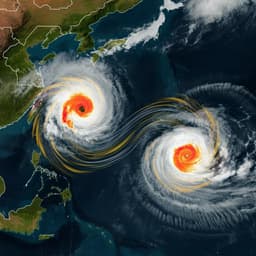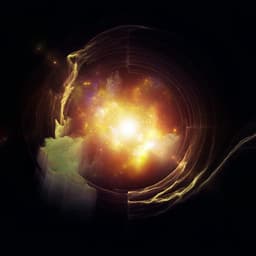
Physics
Can the double-slit experiment distinguish between quantum interpretations?
A. A. Rafsanjani, M. J. Kazemi, et al.
Explore the fundamental aspects of quantum mechanics as researchers Ali Ayatollah Rafsanjani, Mohammad Javad Kazemi, Alireza Bahrampour, and Mehdi Golshani reveal how different interpretations can lead to distinct predictions in a double-slit experiment. Their proposed configuration promises to shed light on the measurement problem and quantum arrival time problem, enhancing our understanding of the quantum world.
Playback language: English
Introduction
Quantum mechanics, while incredibly successful, faces fundamental challenges in areas such as the measurement problem and the quantum arrival time problem. These problems lead to situations where the theory's predictions are not clear-cut or unique. One such area of ambiguity concerns the joint spatiotemporal probability distribution of particle detection events, specifically in the context of the double-slit experiment. Each particle's detection on the screen is inherently random, both in terms of its position and the time of detection. A complete understanding of quantum mechanics requires the ability to predict the joint probability density, P(x, t), which describes the likelihood of a particle arriving at position x at time t. This seemingly simple question has remained open for a considerable time. The traditional approach often employs a semiclassical analysis, assuming particles move along classical trajectories and calculating arrival time distributions using the quantum momentum distribution. However, this simplification is insufficient in the near-field regime, especially considering the quantum backflow effect which violates the assumptions of uniform motion. Recent progress in ultrafast detector technology has made probing this near-field regime feasible, demanding a more detailed theoretical framework. Various quantum interpretations and formulations offer different approaches to defining and calculating the arrival time distribution. Some consider arrival time as a generalized observable described by a positive-operator-valued measure (POVM), while others use realistic trajectory-based formulations like Bohmian mechanics, Nelson stochastic mechanics, or the many-interacting worlds interpretation to derive the distribution from particle trajectories. Phenomenological models, employing path integral formalisms with absorbing boundaries or Schrödinger equations with complex potentials, also exist. While the differences between these methods' predictions are usually small, this paper aims to demonstrate that they become significant enough to be experimentally distinguished, particularly in a modified double-slit setup.
Literature Review
The literature extensively covers the quantum arrival time problem and its various interpretations. Early work by Aharonov and Bohm, and Paul, attempted to define a time operator, but encountered challenges due to the non-self-adjoint nature of these operators. Kijowski's axiomatic approach provided a self-adjoint time operator and a corresponding arrival time distribution, but this approach is not without its complexities and interpretations. Other researchers, inspired by Bohmian mechanics and related approaches, have proposed calculating arrival time distributions directly from particle trajectories. Leavens has explored the relationship between Bohmian mechanics and arrival time distributions, particularly noting the implications of probability backflow. The use of phenomenological models, such as path integrals with absorbing boundaries and Schrödinger equations with complex potentials, has also been investigated. However, the experimental distinction between these different approaches has remained limited, with most experiments occurring in the far-field regime, where the differences between different methods' predictions are not significant. This paper's contribution is to explore the possibility of using the near-field regime in a specific modified double-slit setup to make this distinction experimentally feasible.
Methodology
This research uses numerical simulations to analyze the spatiotemporal arrival distribution of particles in a modified double-slit experiment. Unlike traditional setups with a vertical screen, the authors propose using a horizontal screen, arguing that this geometry magnifies the subtle differences between various interpretations. To simplify the mathematical complexity of Fresnel diffraction from sharp-edged slits, they modeled the slits with soft edges, generating Gaussian wave packets. The wave function is represented as an uncorrelated two-dimensional Gaussian wave packet, incorporating parameters such as slit separation, initial dispersion, and wave packet velocity. The authors select metastable helium atoms as the interfering particles, citing their suitability for current quantum technologies and high-efficiency detection. The paper compares six different methods for calculating the spatiotemporal arrival distribution: the Semiclassical (SC) approximation, and the Standard (STD), Quantum Flux (QF), Bohmian Truncated Current (BTC), Absorbing Boundary Rule (ABR), and Path Integral with Absorbing Boundary (PAB) methods. The SC approximation assumes classical particle motion, computing arrival times from the momentum distribution. The STD method uses a proper arrival time operator. The QF approach uses the absolute value of the quantum probability current perpendicular to the screen. The BTC method is a variation of QF using the Bohmian truncated current to account for particles entering the detector only once. The ABR and PAB methods account for detector back-effects by employing absorbing boundary conditions or a path integral formulation, respectively. The numerical simulations examine the joint spatiotemporal distribution, P(x, t), marginal arrival time distribution, Π(t), conditional local arrival time distribution, Πl(t), and marginal cumulative arrival position distribution, P(x). These simulations use realistic parameters achievable with current technologies, including single-atom detectors capable of high temporal and spatial resolution. For Bohmian mechanics, the simulation involves generating a large number of Bohmian trajectories to determine the arrival times and positions, considering both first and multiple arrivals.
Key Findings
The numerical simulations reveal significant differences in the spatiotemporal arrival distributions predicted by the different theoretical approaches. The horizontal screen configuration accentuates these differences, making them potentially observable. Specifically, the simulations show distinct patterns in the joint spatiotemporal probability distributions, P(x, t), with separated fringes having different shapes and spatial-temporal characteristics for each method. The semiclassical approximation shows well-separated fringes, while the standard method exhibits more continuous fringes. The quantum flux approach shows grooves between fringes. The ABR and PAB methods, which model detector back-action, show more similarities but still have discernible differences. The Bohmian truncated current method (BTC), which focuses on first arrivals, yields a distribution with temporal gaps that correlate with multi-crossing trajectories. Analysis of the marginal arrival time distributions, Π(t), shows increasing differences as the screen distance from the slits decreases. The semiclassical distribution differs significantly from the standard and quantum flux distributions, particularly at earlier times. The average arrival time varies significantly between methods. The cumulative position interference pattern also reveals disparities, with the semiclassical distribution differing significantly from the other two. A detailed analysis of local arrival time distributions, Πl(t), at specific points on the screen reveals further differences. The simulations suggest that these differences are achievable with approximately 10,000 detection events, which is within the capability of current technology. The study also distinguishes between different detection schemes in Bohmian mechanics, such as unilateral versus bilateral detection and whether the detector is a barrier or allows multiple crossings. Finally, comparing the ABR, PAB, and BTC methods that explicitly account for detector back-action, the study highlights differences in marginal distributions and average arrival times, again emphasizing the potential for experimental discrimination.
Discussion
The findings demonstrate that the choice of quantum interpretation significantly impacts the predictions of spatiotemporal arrival distributions in the double-slit experiment, particularly when considering a horizontal screen in the near-field regime. The differences between various theoretical approaches are not simply subtle mathematical nuances; they result in experimentally discernible variations in observable quantities such as the joint spatiotemporal probability density, the marginal arrival time distribution, and the cumulative position distribution. The ability to experimentally differentiate between these predictions offers a crucial test of the underlying assumptions of different quantum interpretations. The fact that these differences are potentially measurable with current technologies—specifically fast and high-resolution single-atom detectors—makes this a significant advancement in our ability to probe the foundational aspects of quantum mechanics. This experiment does not definitively 'choose' one interpretation over another, but instead provides a clear empirical tool for discriminating between them, driving further theoretical investigation and refinement. The results highlight the importance of considering the detector's back-action in experiments probing quantum foundations.
Conclusion
This paper presents a feasible experimental setup to distinguish between various quantum interpretations using a modified double-slit experiment with a horizontal screen. The numerical simulations demonstrate significant, experimentally testable differences in spatiotemporal arrival distributions predicted by different theoretical frameworks. Future research could explore the use of heavier condensate atoms or entangled atoms for even clearer distinctions. Investigating the applicability of this approach to photons, while potentially advantageous practically, requires more careful theoretical consideration of relativistic effects, which is left for future studies.
Limitations
The model simplifies the double-slit setup by using Gaussian wave packets with soft edges to avoid the complexities of Fresnel diffraction from sharp edges. While this simplification facilitates the analysis, it might not entirely capture the intricacies of a real-world double-slit experiment. The numerical simulations rely on specific parameter choices for the experimental setup and the theoretical models. While these parameters are within the range of current experimental capabilities, variations in these parameters might affect the magnitude of the differences between the various theoretical predictions. Furthermore, the study focuses on a specific type of particle (metastable helium atoms), and the results might not directly translate to other particle types without further investigation.
Related Publications
Explore these studies to deepen your understanding of the subject.







